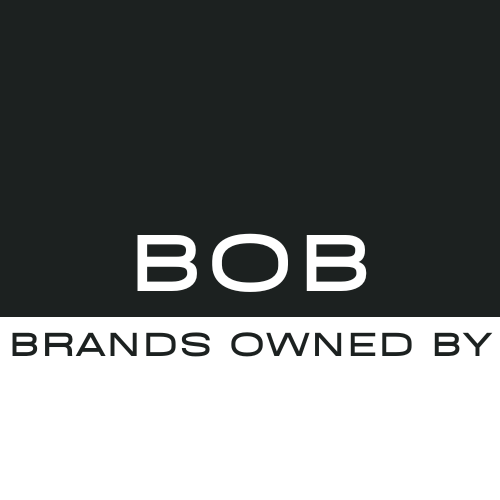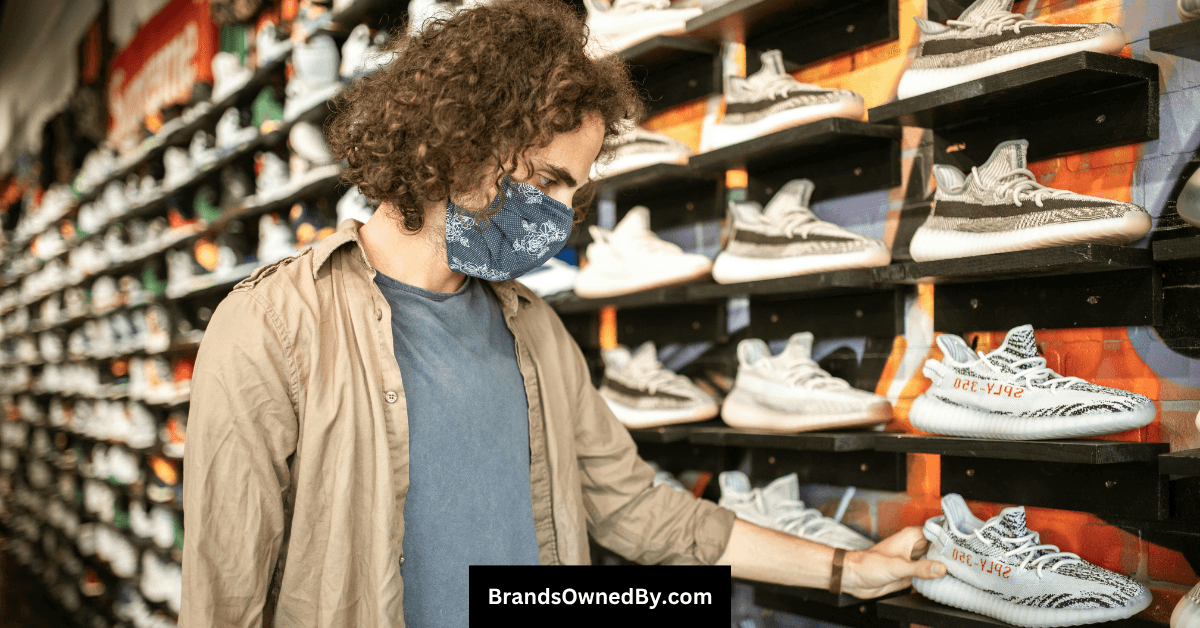Adidas is one of the most recognized sportswear companies in the world. The question “who owns Adidas” often arises due to its long history, wide brand presence, and global operations. Here’s a detailed breakdown of its ownership, leadership, financial performance, and the companies it owns.
Adidas Company Profile
Adidas is one of the world’s leading sportswear manufacturers, producing footwear, apparel, and accessories for athletes and fashion-forward consumers. Headquartered in Herzogenaurach, Germany, the brand is globally recognized by its iconic three stripes logo and its consistent innovation in performance and lifestyle wear.
In 2025, Adidas operates in over 160 countries with more than 50,000 employees. Its product lines span athletic shoes, activewear, outdoor gear, digital fitness services, and collaborations with celebrities and designers. The brand remains in direct competition with Nike and Puma while maintaining strong regional leadership in Europe and Asia.

Company Details
- Full Name: Adidas AG
- Founded: August 18, 1949
- Founder: Adolf “Adi” Dassler
- Headquarters: Herzogenaurach, Bavaria, Germany
- Stock Exchange: Frankfurt Stock Exchange (Ticker: ADS)
- Employees: Over 50,000 globally (2025)
- CEO: Bjørn Gulden (since 2023)
- Revenue (2024): Approx. €22 billion
- Global Reach: Products sold in 160+ countries.
Adidas operates with a strong focus on sustainability, digital transformation, and product innovation. Its business model combines wholesale distribution, direct-to-consumer retail, and robust e-commerce platforms.
Founders
Adidas was founded by Adolf Dassler, a German cobbler and inventor. Before founding Adidas, Adi Dassler and his brother Rudolf Dassler co-managed the Gebrüder Dassler Schuhfabrik, which gained fame when Jesse Owens wore their track shoes in the 1936 Berlin Olympics.
After a fallout between the brothers, Adolf created Adidas in 1949, while Rudolf went on to create Puma, Adidas’s long-standing rival. Adolf Dassler registered the company and introduced the now-famous three-stripe trademark to distinguish his shoes from others.
Adi Dassler passed away in 1978, but his legacy continues through the company’s dedication to performance, quality, and sports culture.
Major Milestones
1949 – Foundation of Adidas
Adi Dassler founded Adidas and registered its iconic three-stripe design the same year.
1954 – World Cup Breakthrough
The West Germany national football team won the FIFA World Cup wearing Adidas boots with screw-in studs. This moment catapulted Adidas to global recognition.
1971 – Introduction of the Trefoil Logo
Adidas launched the trefoil logo, symbolizing performance and lifestyle branding. It became the face of Adidas Originals.
1990s – Global Expansion and IPO
Adidas went public in 1995, listing on the Frankfurt Stock Exchange. It expanded rapidly into North America and Asia.
2006 – Acquisition of Reebok
To challenge Nike in the U.S. market, Adidas acquired Reebok for $3.8 billion. However, the brand struggled under Adidas and was later sold in 2022.
2011 – Acquisition of Five Ten
Adidas bought climbing brand Five Ten, expanding into the outdoor adventure gear market.
2015 – Acquisition of Runtastic
Adidas entered the digital fitness space by acquiring Runtastic for over $200 million, strengthening its tech-driven product strategy.
2020–2022 – Major Partnerships and Shifts
Adidas ended its partnership with Kanye West in 2022, cutting ties with the Yeezy brand following controversies. This impacted short-term sales but allowed a repositioning of its brand.
2023 – New CEO and Brand Renewal
Bjørn Gulden, former CEO of Puma, joined as Adidas’s new CEO. Under his leadership, the brand began focusing on performance-driven products, stronger athlete partnerships, and regional growth in Asia-Pacific.
2025 – Strength in Sustainability and Tech
Adidas in 2025 is recognized for its progress in sustainability, including shoes made from ocean plastic, fully recyclable sneakers, and carbon-neutral manufacturing goals. It also continues developing smart shoes and AI-integrated apparel using data from its Runtastic platform.
Who Owns Adidas: Major Shareholders
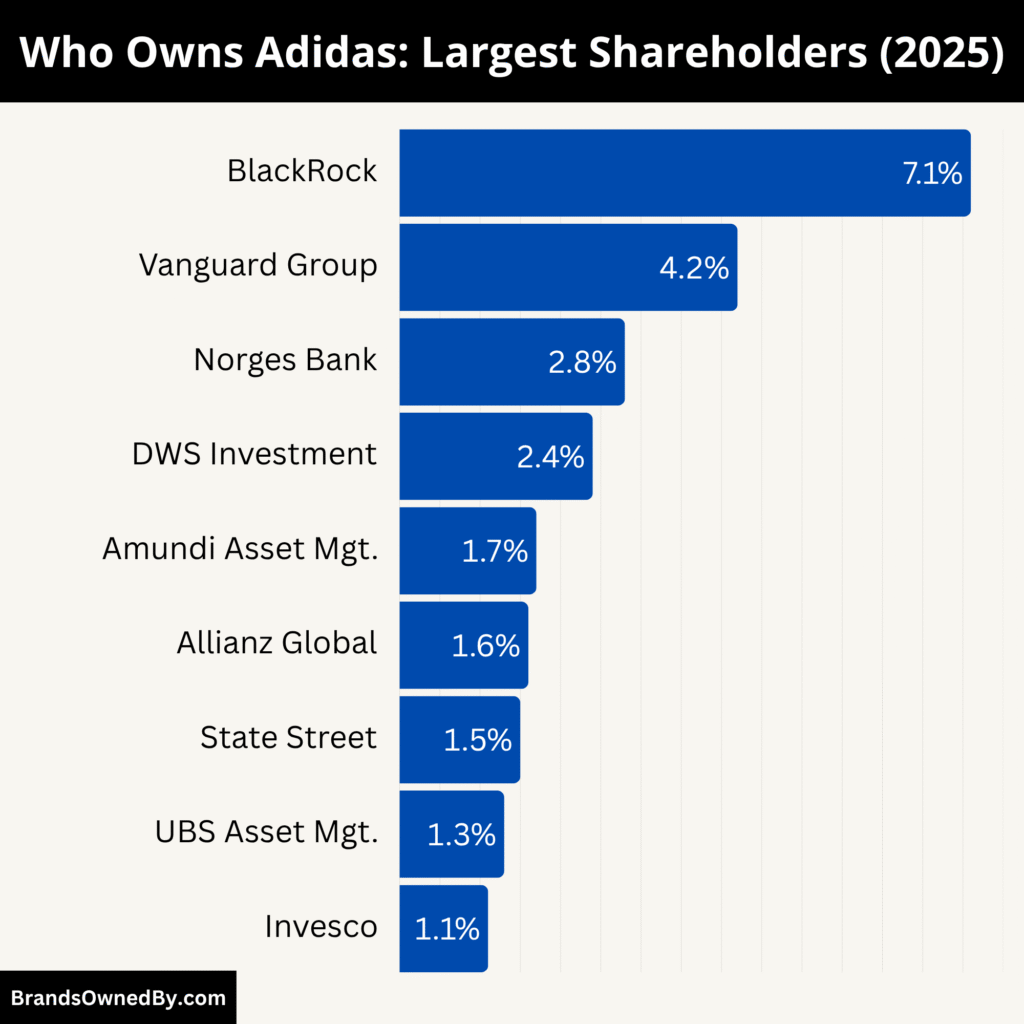
Adidas is a publicly traded company listed on the Frankfurt Stock Exchange under the ticker symbol ADS. That means no single person or family owns the entire company. Instead, it is owned by a combination of institutional investors, individual shareholders, and other stakeholders.
The largest shareholders are mainly asset management firms, investment companies, and pension funds. These entities control significant voting rights and influence major company decisions through their stakes.
Here’s a list of the largest shareholders of Adidas as of July 2025:
| Shareholder | Estimated Ownership (July 2025) | Description |
|---|---|---|
| BlackRock Inc. | ~7.1% | Largest shareholder; passive investor with strong ESG voting influence. |
| The Vanguard Group | ~4.2% | U.S.-based index fund manager; supports long-term governance and stability. |
| Norges Bank (Norway SWF) | ~2.8% | Sovereign wealth fund; promotes ethical governance and responsible investing. |
| DWS Investment GmbH | ~2.4% | German asset manager; aligns with local interests and corporate governance. |
| Amundi Asset Management | ~1.7% | French investment firm; focuses on ESG integration and active voting. |
| Allianz Global Investors | ~1.6% | German institutional investor; conservative and growth-focused. |
| State Street Global Advisors | ~1.5% | U.S.-based passive investor; supports board diversity and ESG proposals. |
| UBS Asset Management | ~1.3% | Swiss investor; backs sustainability and long-term performance strategies. |
| Invesco Ltd. | ~1.1% | Global fund manager; promotes transparency and ethical practices. |
| Retail & Small Shareholders | ~20–25% (combined) | Individual and small investors; limited control but benefit from dividends. |
| Other Institutions (combined) | ~50%+ (combined) | Includes mutual funds, pensions, and banks; hold majority voting power. |
BlackRock Inc.
As of July 2025, BlackRock remains the largest institutional shareholder of Adidas, holding approximately 7.1% of the company’s outstanding shares. The firm manages this stake through various equity index funds and ETFs that include Adidas in their European and global portfolios.
While BlackRock does not participate in Adidas’s daily operations, its large voting power allows it to influence key corporate matters, such as board appointments and sustainability-related proposals. The firm often backs decisions that align with long-term shareholder value and ESG priorities.
The Vanguard Group
The Vanguard Group holds roughly 4.2% of Adidas shares through its passive and actively managed funds. Based in the United States, Vanguard includes Adidas in many of its international stock indices.
Although Vanguard rarely engages directly in operational decisions, it consistently exercises its proxy voting rights. The firm is known for supporting corporate governance reforms and long-term strategies focused on stable financial performance and shareholder returns.
Norges Bank Investment Management
Norway’s sovereign wealth fund, managed by Norges Bank Investment Management, owns around 2.8% of Adidas as of mid-2025. This investment is part of the fund’s broader strategy to diversify globally across high-performing companies.
While not an activist investor, Norges Bank is vocal about ethical business practices, responsible sourcing, and transparency in corporate governance. It regularly votes in shareholder meetings and promotes sustainable practices across its portfolio.
DWS Investment GmbH
DWS Investment GmbH, a subsidiary of Deutsche Bank, is one of Adidas’s most prominent German institutional shareholders. With a stake of approximately 2.4%, DWS reflects domestic confidence in Adidas’s long-term growth.
The firm participates in shareholder voting and typically supports board decisions that align with strong financial performance and environmental commitments. Its presence ensures a local institutional voice in the company’s governance.
Amundi Asset Management
Amundi, Europe’s largest asset manager based in France, holds an estimated 1.7% of Adidas shares. The firm invests in Adidas through several actively managed European equity funds.
Amundi’s approach emphasizes ESG integration, and it actively votes in support of climate action, supply chain ethics, and labor rights when relevant resolutions are proposed. Though its stake is smaller, its voting patterns are consistent with sustainable business principles.
Allianz Global Investors
Allianz Global Investors, affiliated with the German insurance giant Allianz, owns about 1.6% of Adidas shares. It maintains Adidas within its core European equity portfolios. Allianz has long been a supporter of conservative growth strategies, consistent dividend returns, and effective risk management.
The firm’s influence lies in its long-standing ties with Germany’s corporate sector and steady engagement with executive leadership through shareholder meetings.
State Street Global Advisors
State Street Global Advisors (SSGA), one of the world’s largest passive investment firms, holds roughly 1.5% of Adidas shares as of July 2025. SSGA invests primarily through index-tracking strategies and includes Adidas in its European and global funds.
It does not engage in direct management but actively participates in proxy voting, often supporting diversity, sustainability, and board independence initiatives.
UBS Asset Management
UBS Asset Management holds an estimated 1.3% of Adidas through a mix of European growth and income-focused funds. The Swiss-based investor generally supports the company’s focus on sustainability and innovation. While UBS’s holding is relatively modest, it aligns itself with other long-term institutional investors in supporting shareholder proposals that promote stable returns and strong ethical governance.
Invesco Ltd.
Invesco, a U.S.-based asset management firm, owns about 1.1% of Adidas as of July 2025. The company includes Adidas in several of its European equity funds, especially those targeting consumer and lifestyle sectors. Invesco uses its voting rights to support transparency in executive pay, carbon footprint disclosure, and improved shareholder communication. While not a controlling stakeholder, its consistent engagement adds to the institutional pressure for responsible business practices.
Retail and Other Shareholders
Beyond institutional investors, around 20–25% of Adidas shares are held by retail investors and smaller funds. These include private individuals, family offices, and regional financial firms that purchase shares through public exchanges.
Though each investor holds a small portion, collectively they represent a substantial ownership block. Their influence is limited due to their dispersed nature, but they participate in annual meetings and benefit from dividend payouts and share price growth.
Other Global Institutional Investors
Adidas’s remaining shares are widely distributed among hundreds of institutional investors across Europe, North America, and Asia. These include pension funds, insurance companies, and mutual funds that maintain long-term holdings in Adidas for stable returns.
Collectively, institutional investors control more than 70% of the company, giving them considerable voting power in strategic decisions, including leadership appointments, major acquisitions, and ESG policy direction. Their widespread support ensures Adidas remains publicly accountable and aligned with global financial standards.
Who is the CEO of Adidas?
As of 2025, Bjørn Gulden serves as the Chief Executive Officer of Adidas. He officially took over the role on January 1, 2023, succeeding Kasper Rørsted. Gulden’s appointment came during a pivotal time for Adidas, following financial turbulence and the termination of major collaborations, including its high-profile partnership with Kanye West. His leadership is seen as a strategic reset aimed at restoring brand identity, improving operational efficiency, and refocusing on core sports categories.
Bjørn Gulden is a well-known figure in the sportswear industry. Prior to joining Adidas, he was the CEO of Puma from 2013 to 2022, where he played a key role in revitalizing the brand. He also held leadership roles at Deichmann, Helly Hansen, and Adidas itself earlier in his career. His return to Adidas as CEO marked a full-circle moment and brought a renewed emphasis on performance, authenticity, and athlete-centered design.
Leadership Approach and Strategic Focus
Under Gulden’s leadership, Adidas has doubled down on product innovation, regional growth, and athlete partnerships. He has prioritized rebuilding Adidas’s reputation among consumers, focusing more on grassroots sports, football, and running segments. Unlike the fashion-heavy approach of previous years, Gulden has steered the brand back toward performance excellence.
He has also led major investments in Asia-Pacific markets, improved direct-to-consumer operations, and revitalized product pipelines across Adidas Originals and Terrex. One of his major initiatives includes increasing the speed of product delivery from design to shelf — a move aimed at competing more directly with Nike and fast-moving Asian brands.
Management Structure
Adidas operates under a dual-board system, common in German corporate governance. The structure includes:
- Executive Board: Led by the CEO, responsible for operational decisions, product strategies, marketing, and supply chain management.
- Supervisory Board: Oversees the Executive Board and is involved in approving major financial decisions, mergers, and leadership appointments.
Gulden chairs the Executive Board and works closely with other board members, overseeing finance, HR, global sales, and digital business.
Previous CEOs of Adidas
Kasper Rørsted (2016–2022) served before Gulden and is credited with modernizing Adidas’s digital infrastructure and improving profit margins. However, his tenure was marked by overreliance on celebrity partnerships and weakening ties with core sports markets.
Herbert Hainer (2001–2016) led the company through some of its strongest growth years, including the acquisition of Reebok. He focused heavily on global expansion, brand segmentation, and product diversification.
Each CEO brought a different focus — but in 2025, Gulden’s leadership is viewed as a return to Adidas’s athletic roots while preparing it for the demands of a highly competitive global market.
Adidas Annual Revenue and Net Worth
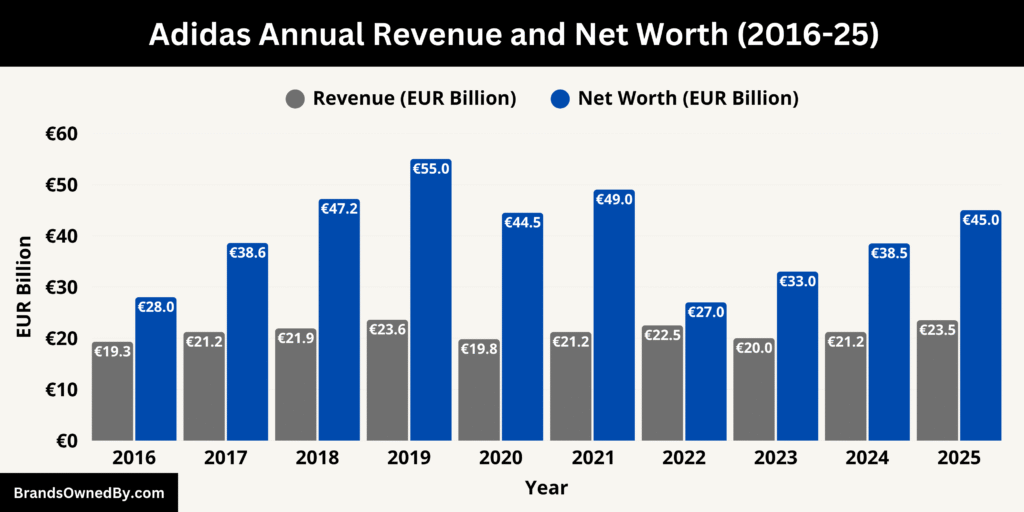
Adidas reported trailing twelve-month revenue of approximately €2.3.5 billion as of March 31, 2025, marking nearly 12.8 % growth compared to a year earlier. This figure reflects strong momentum following a solid 2024, where annual sales reached €23.68 billion—a year-over-year increase of over 10 % in euro terms.
The growth in 2025 was powered by direct-to-consumer channels, which rose about 15 %, and wholesale revenue growth of roughly 18 %, led by high demand for Originals and performance footwear. Excluding Yeezy sales from previous years, growth is estimated at over 10 % in currency-neutral terms.
Operating Profit Outlook (2025)
For fiscal 2025, Adidas projects operating profit in the range of €1.7 billion to €1.8 billion. This outlook is below some analyst expectations but reflects a cautious tone given ongoing geopolitical and macroeconomic risks, such as tariffs on imports from China, Canada, and Mexico. Operating profit in this range indicates solid profitability, though it falls short of previous benchmarks around €2.3 billion that analysts had forecast.
Market Value / Net Worth (Market Capitalization)
As of July 2025, Adidas’s market capitalization stood at approximately $43 billion, making it one of the top 500 most valuable companies globally. Converted into euros, this equates to roughly €45 billion, depending on exchange rates. Enterprise value, which accounts for debt and cash, is estimated at around $48 billion.
Financial Performance
Adidas’s financial trajectory in 2025 reflects measured recovery and resilience. Revenue is accelerating into double-digit growth while the company resets after exiting the Yeezy business. Operating margins remain stable, even as tariffs introduce cost pressure. The dividend proposed in May 2025 rose to €2.00 per share—up from €0.70 the year before—demonstrating confidence in cash flow and profitability.
Meanwhile, Adidas remains committed to sustainable, regionally diversified growth, with Latin America and Asia posting the strongest increases and emerging markets expanding rapidly under leadership initiated in 2023.
Companies Owned by Adidas
Below is a list of the major companies and brands owned by Adidas as of 2025:
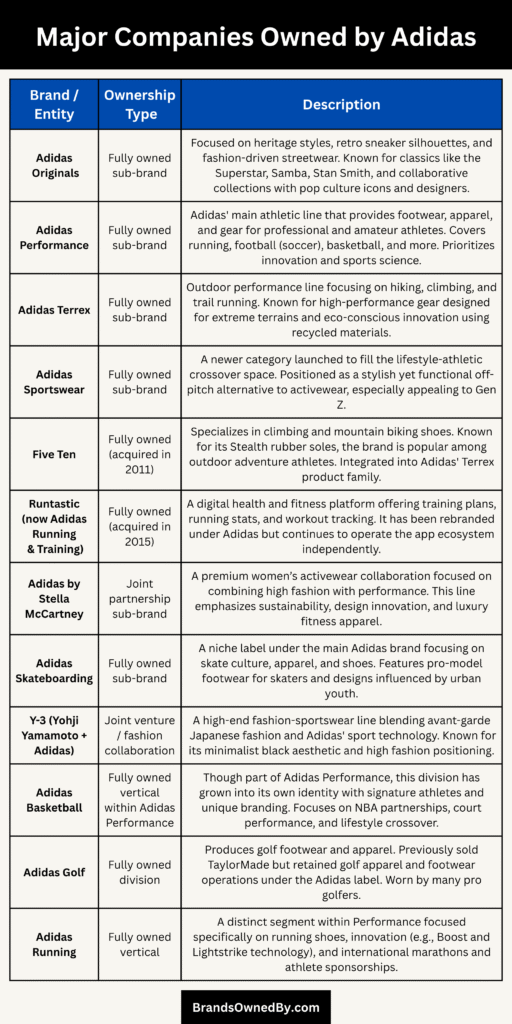
Adidas Originals
Adidas Originals is one of the most iconic and commercially successful brand divisions under Adidas. It focuses on heritage and lifestyle-inspired products, including retro sneakers, streetwear, and fashion collaborations. As of 2025, Adidas Originals continues to be a major driver of revenue in urban markets, especially in North America, Asia, and Europe. The division is known for classic products like the Superstar, Stan Smith, Samba, and Gazelle—many of which have been reimagined through limited-edition drops and designer partnerships. Originals is central to Adidas’s appeal among Gen Z and millennial consumers.
Adidas Performance
Adidas Performance is the core sportswear division that focuses on professional-level gear for sports such as football (soccer), running, basketball, training, and tennis. In 2025, it remains the technical heart of the brand, with innovations in performance fabrics, footwear cushioning, and data-integrated gear. Signature product lines include the Predator and X football boots, Ultraboost and Adizero running shoes, and the Parley for the Oceans collection featuring sustainable materials. The division is heavily endorsed by athletes and national teams globally.
Adidas Terrex
Adidas Terrex is the company’s outdoor performance brand. It serves hikers, trail runners, climbers, and adventure athletes. Adidas expanded Terrex’s product offering in 2025 with new weatherproof hiking gear, trail running shoes, and eco-conscious apparel. It is marketed toward consumers who seek both function and environmental responsibility. Terrex also benefits from the integration of Five Ten’s climbing technology and appeals to the growing outdoor sports lifestyle market.
Adidas Sportswear
Launched as a standalone category in recent years, Adidas Sportswear bridges the gap between performance gear and lifestyle clothing. This division targets everyday comfort and casual athletic style, focusing on minimalist, versatile apparel suitable for travel, work, and light fitness. In 2025, it has grown significantly through influencer campaigns and athleisure trends. This brand line plays an important role in competing with the lifestyle segments of Nike, Lululemon, and Under Armour.
Five Ten
Adidas acquired Five Ten in 2011, and it remains a vital part of its outdoor business in 2025. Known for its high-friction climbing and mountain biking shoes, Five Ten has a strong reputation among professional athletes and outdoor enthusiasts. Its integration into Adidas Terrex has allowed for co-branded innovations in grip technology and rugged footwear. Five Ten products are sold through both niche outdoor retailers and Adidas’s global e-commerce platforms.
Runtastic (now Adidas Running App)
Runtastic was acquired by Adidas in 2015 and has since been transformed into the Adidas Running App, part of the company’s digital sports ecosystem. It allows users to track workouts, monitor progress, and access training plans. In 2025, the app supports millions of active users and is integrated with smartwatches and fitness trackers. It plays a strategic role in gathering consumer data and building direct-to-consumer engagement through personalized fitness content and product recommendations.
Adidas by Stella McCartney
This is a long-running collaboration between Adidas and British designer Stella McCartney. The partnership focuses on sustainable and stylish sportswear, particularly targeting women. The line includes performance leggings, jackets, shoes, and accessories made from recycled or plant-based materials. In 2025, Adidas by Stella McCartney continues to strengthen its niche appeal among fashion-forward consumers who prioritize ethical production and high-performance design.
Y-3 (Yohji Yamamoto Collaboration)
Y-3 is a high-fashion label created through Adidas’s ongoing collaboration with Japanese designer Yohji Yamamoto. Launched in 2002, the brand remains active in 2025 and offers avant-garde, fashion-forward sportswear with a monochrome aesthetic. Y-3 is part of Adidas’s long-term commitment to blending sports performance with contemporary design. It serves as a cultural bridge between luxury fashion and athletic innovation.
Adidas Skateboarding
Adidas Skateboarding is a specialized product division dedicated to skateboarding shoes, apparel, and accessories. In 2025, this segment has grown steadily, gaining popularity in North America, Japan, and parts of Europe. With a roster of pro skaters, including influential youth ambassadors, the division promotes authentic engagement with the skateboarding community while introducing lifestyle collections that crossover into streetwear.
Adidas Golf
Adidas Golf continues to operate as a key division, even after selling off its TaylorMade golf equipment business years ago. The brand now focuses on golf apparel, shoes, and accessories. In 2025, Adidas Golf maintains partnerships with major professional golfers and sponsors events worldwide. It emphasizes comfort, lightweight materials, and eco-friendly product development tailored for both amateur and professional golfers.
CONFIRMED App and Adidas eCommerce Platforms
CONFIRMED is Adidas’s exclusive app-based platform used for product drops, limited-edition releases, and early access to collaborations. It’s part of Adidas’s broader digital strategy, which includes its main e-commerce website and mobile platforms. By 2025, these digital channels account for more than 30% of total sales, reflecting a strategic shift to direct-to-consumer engagement and community building.
Adidas Research and Development (A.R.D.)
While not a consumer-facing brand, Adidas R&D is a critical in-house division responsible for technological innovation. Located primarily in Germany and the U.S., its labs focus on performance innovation, materials engineering, 3D printing, and sustainability. In 2025, this unit continues to develop biodegradable shoes, AI-powered product design systems, and energy-efficient production methods used across all Adidas products.
Final Thoughts
Understanding who owns Adidas reveals how public corporations operate through institutional ownership and shareholder structures. Though no single entity owns Adidas entirely, major asset managers like BlackRock and Vanguard hold significant influence. The company’s leadership, strong brand presence, and diversified product lines ensure it remains a major force in the global sportswear market.
FAQs
What does Adidas mean?
The name “Adidas” is derived from the founder’s name, Adolf “Adi” Dassler. It combines his nickname “Adi” and the first three letters of his last name, “Dassler.” It does not stand for “All Day I Dream About Sports,” which is a popular myth.
Who owns Adidas company?
Adidas is a publicly traded company listed on the Frankfurt Stock Exchange. It does not have a single owner but is owned by a mix of institutional investors, individual shareholders, and company insiders. Major shareholders include entities like Groupe Bruxelles Lambert, BlackRock, and The Vanguard Group.
Who is Adidas’ biggest shareholder?
As of July 2025, Groupe Bruxelles Lambert (GBL) is the largest shareholder of Adidas, holding just over 7% of total shares. GBL is a Belgian holding company known for its long-term investments in global firms.
Who is the original owner of Adidas?
Adidas was founded by Adolf “Adi” Dassler in 1949 in Herzogenaurach, Germany. He had previously co-founded a shoe company with his brother Rudolf Dassler, who later founded Puma after a family split.
Who owns Adidas brand?
The Adidas brand is owned by Adidas AG, the parent company that also manages its sub-brands and divisions. Adidas AG holds all the intellectual property, logos, and trademarks associated with the brand.
How much does BlackRock own of Adidas?
As of mid-2025, BlackRock Inc. owns approximately 5.1% of Adidas AG’s outstanding shares. It is one of the largest institutional shareholders and holds influence primarily through its passive investment funds and ETFs.
Who founded Adidas?
Adidas was founded by Adolf Dassler in August 1949. He registered the company as “Adi Dassler adidas Sportschuhfabrik” and began with 47 employees in Herzogenaurach, Germany.
Is Adidas a private company?
No, Adidas is not a private company. It is a publicly traded corporation, listed on the Frankfurt Stock Exchange under the ticker ADS. Its shares are available to both institutional and retail investors.
What brands does Adidas sell?
Adidas owns and sells a variety of brands and sub-brands including:
- Adidas Originals
- Adidas Performance
- Terrex
- Five Ten
- Y-3 (with Yohji Yamamoto)
- Adidas by Stella McCartney
- Adidas Skateboarding
- Adidas Golf
Additionally, it operates digital platforms like the CONFIRMED app and the rebranded Adidas Running (formerly Runtastic).
Is Adidas a German company?
Yes, Adidas is a German multinational corporation. It was founded in Germany and is still headquartered in Herzogenaurach, Bavaria. It remains one of the most prominent German consumer brands globally.
Is Adidas a publicly traded company?
Yes, Adidas is publicly traded. It is listed on the Frankfurt Stock Exchange and included in Germany’s DAX stock index. Shares are traded under the ticker symbol ADS.
Who owns Adidas and Puma?
Adidas and Puma are independent companies. Adidas is owned by its shareholders through public markets, with major institutional investors like GBL and BlackRock. Puma is separately owned and controlled, with Kering and Artémis having previously held major stakes. The two brands were originally started by rival brothers—Adi and Rudolf Dassler.
Who is the parent company of Adidas?
Adidas AG is its own parent company. It is not owned by any other firm or conglomerate. All its operations and sub-brands fall under Adidas AG.
Who are the main stakeholders in Adidas?
Key stakeholders in Adidas include:
- Groupe Bruxelles Lambert (GBL)
- BlackRock Inc.
- The Vanguard Group
- Norges Bank Investment Management
- Amundi Asset Management
- Retail investors and employees (via stock ownership and pension funds)
These stakeholders influence governance, dividend policy, and long-term strategy.
Where is Adidas’ headquarters?
The global headquarters of Adidas is located in Herzogenaurach, Bavaria, Germany. This is the same town where it was originally founded in 1949 and where its main R&D and administrative functions continue to operate.
Who is the CEO of Adidas?
Bjørn Gulden is the CEO of Adidas as of 2025.
Does Adidas own Reebok?
No, Adidas sold Reebok to Authentic Brands Group in 2022.
How much is Adidas worth?
As of July 2025, Adidas has a market value of more than €45 billion.
